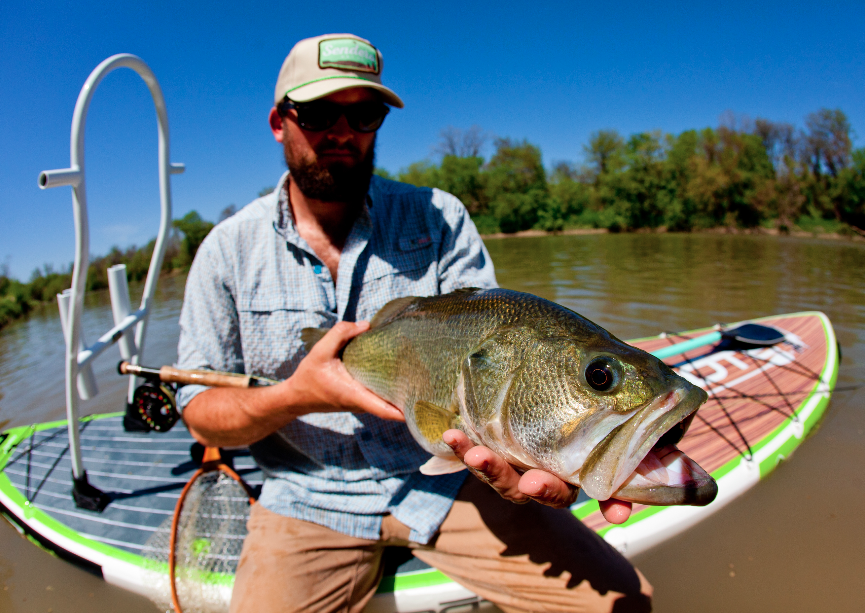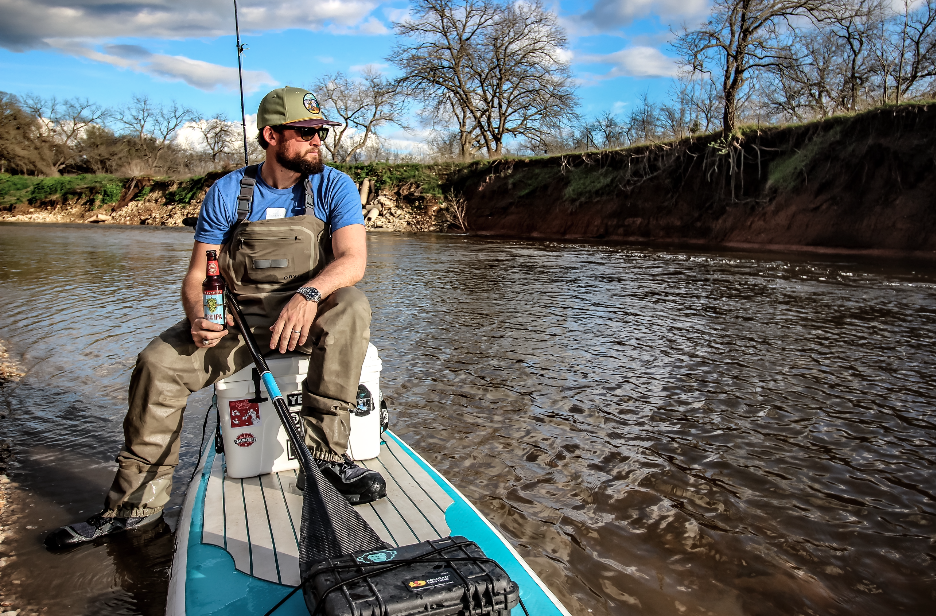Stand Up Paddleboard Fishing- Texas Style
Words by Hunter Harlow | Photos by Greg Smith
Mobility, point of view, and freedom, are the reasons I left the shore for my inland board. There is something exhilarating about carefully maneuvering into position, focusing enough to balance and land a 30 foot cast into the perfect spot, and then setting the hook and landing a fish all from a standup paddle board. Whether you’re inland or coastal, fishing from a SUP can add an extra dimension to your game. If nothing else, it’s just down right fun.
I grew up fishing the lakes, rivers, and creeks of North and Central Texas. Fishing is in my genetics, but it didn’t take off until I started fly fishing 6 years ago. During that span, I have had the pleasure of fishing in 14 states and 6 countries, many of those on my SUP. It’s safe to say I am thoroughly addicted. I can clearly recall catching my first largemouth bass, rainbow trout, redfish, and everything in between. Just as comparable an experience is catching my first fish from a paddle board. SUP fishing is not complicated, but it does involve a small of amount of research and practice.
Getting Started
If you want to get into the game, you need to decide if you want a fiberglass or inflatable board. Inflatables have come a long way, and many will pack down into a reasonable sized bag. Personally, I prefer inflatable because of the ease of transportation. My BOTE Drift has been in trucks, trailers, and airplanes and has garnered little more than a few scars. However, there are some benefits to fishing on glass, such as increased stability, speed, and capacity. Advances in accessories have also benefited SUP fishing. Now you can get a board with tackle racks, Yeti strap-downs, anchor capabilities, cup holders, and all kinds of storage. Basically whatever you see on any decked-out kayak rig, you can find on a SUP.
Texas has a lot to offer in terms of fishing variety- open lakes, slow rivers, flowing streams, and shallow salt flats, each requiring their own SUP skills. First, to be able to hit any or all of these for a SUP fishing sesh, there is one thing you have to master - balance. If you’re a beginner, you need to practice getting on your board, standing up, and paddling. Contrary to most preconceived ideas about paddle boarding, if you get the right board, stability shouldn’t be an issue. Fishing SUPs have little in common with the board you rented for an hour on your last beach vacation. These boards are made to hold coolers, tackle, and upwards of 500 pounds all while moving on the water or while casting. Most SUP brands have designated their boards for certain activities, and if you make sure yours is for fishing, you should be fine in this category.
Second, you need to practice casting from your board. This is especially challenging for fly fishers. Big motions during false casting create a rocking motion on your SUP, and if you are in choppy or flowing water, this can be challenging. You have to learn to be concise.
Third, learn to play the wind and current. They can be an issue, but only if you let them be. Even though SUPs have a low profile in the water, they are still susceptible to wind drag. If you learn to read the wind and you have confidence as paddler, you will eventually learn to plan routes where your drift will naturally take you through areas of interest. Balance and taking a good line are the two most critical skills. Whitewater SUPing is becoming a huge sport, and even though we don’t have a lot of that in Texas, there are some places these techniques apply. Eddying out, a more vertical stance, and riding with more weight on the stern are things you’ll want to practice.
Lastly, there are some minor things you will come across like carefully placing your excess fly line if you are a fly fisher, efficiently dropping and picking up your paddle while casting, and accessing your gear on different parts of the board. You’ll figure those out with experience, so just a heads up.
Texas Waters
My home is Central Texas. I am thoroughly impressed with the abundance of fisheries I have within an hour’s drive or less, many of which are underutilized or completely unheard of. Weekly, you can find me on the Brazos, Middle Bosque, Guadalupe, or Colorado Rivers and lesser known fisheries like Childress, Hog, Barton Springs, or Bull Creeks. For the most part, Texas is largemouth bass country. If there is only one thing I can tell you about how to bass fish, it is to fish structure. Structure is anything that creates a habitat for bait fish and areas for larger fish to ambush prey. It can be natural or man-made and include downed trees, shelves, large rocks, bridges, dams, docks- the list is endless. During the warmer months, fishing poppers or other top water flies/lures can be some of the most exciting fishing out there. But if that’s not working, fish all zones of the water column by using different types of flies/lures with some weight or diving capabilities. I’ve found colors that mimic baitfish - chartreuse, black, and oliveare the most effective. If you’re fly fishing, use a 4 through 8 weight rod and line.
Another fun species to target on a paddleboard is striped bass. Striper have been introduced into a handful of Texas reservoirs and have subsequently found themselves in the tail waters under most dams. Open water striper are fun, but to ultimately be successful, you need a boat. However, river striper are more isolated, and having a SUP can put you places bank fisherman can’t reach. This fishing is predominately about coverage. Long casts through areas where bait fish get trapped in eddies, confluences, shelves are the key. Check to see if your local reservoir has striper, and if they do, more than likely you will find them below the dam as well. Throw large, bright flies/lures and retrieve them fast with a little twitch. These fish are particular and smart, but when you catch one - hold on! - because they can get massive. Fly fishers, I would use an 8 through 10 weight.
If you think you have your SUP skills and fishing skills honed in and you have an itching for the salt life, Texas coastal fishing is some of the best around. Sight casting to a school of tailing reds from a paddle board will give you an adrenaline rush that borderlines on illegal. This is tricky fishing though, and it requires stealth, efficiency, and a research. Make sure your fishing equipment is salt approved, and if it’s not, be sure to wash it thoroughly after use in the salt water. There are a number of flats easily accessible from places like Port O’Connor, Rock Port, South Padre, and even some hidden gems near Houston and Galveston. If you’re hitting the flats, make sure you get a map or GPS and learn the tides; as this can make or break you. The trick here is so see the fish, get into position, and place a cast where the fish’s path will intersect it, all without spooking it. Trust me, if you’re starting out this will take practice and you’ll blow opportunities, but it’s well worth it. Throw crab or shrimp imitation flies/lures, or my personal favorite… the gold spoon. Fly fishermen, I would use a 7 to 9 weight.
Up Your Game, Up Your Fun
With the right amount of practice, patience, and dedication, adding a SUP to your fishing regimen can put you on fish that were previously unreachable. Better yet, you get to add a new perspective from a higher vantage point, and you’ll have a blast doing it. During my paddle boarding career, I have found that being able to stand up and target specific areas or individual fish is a game changer. I have an affinity for fishing hard-to-get-to Texas tributaries, so a paddle board has made all the difference; especially an inflatable. Lastly, being able to easily sit on my cooler, lay down, sit in the water, and get from the water back up on the board is light years easier on a SUP than a kayak (sorry kayak friends, that’s just science). Texas is a paddle board fishing paradise, and it has a lot to offer in terms of species, water, and scenery. Regardless if you take up paddle boarding, make sure you get out there and explore it! And from my friends at Texas Parks and Wildlife, be sure to get the appropriate fishing license and look up the rules and regulations for your water and target species.
Hunter Harlow on Childress Creek with his Yeti cooler and Bote Board
by Hunter Harlow



